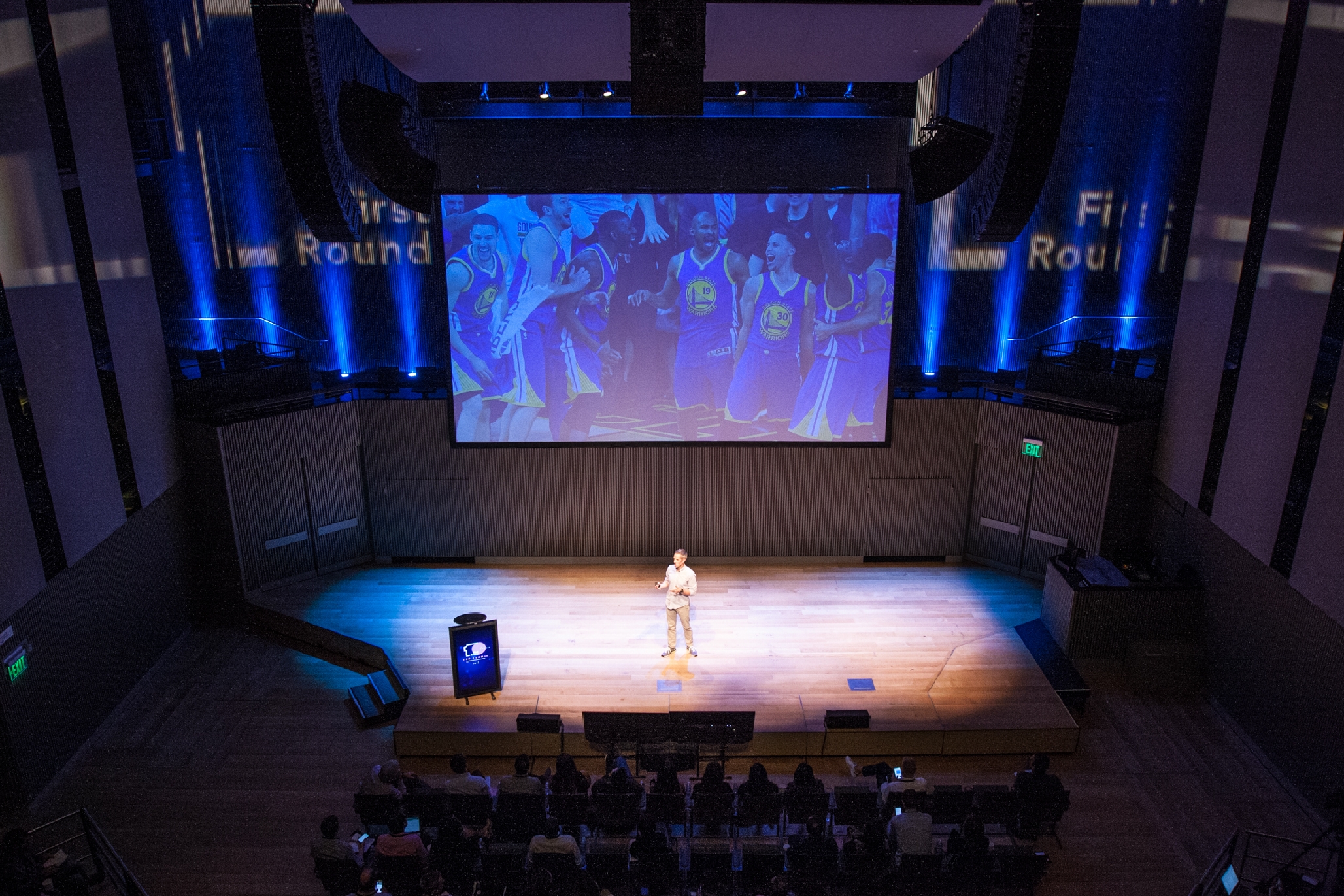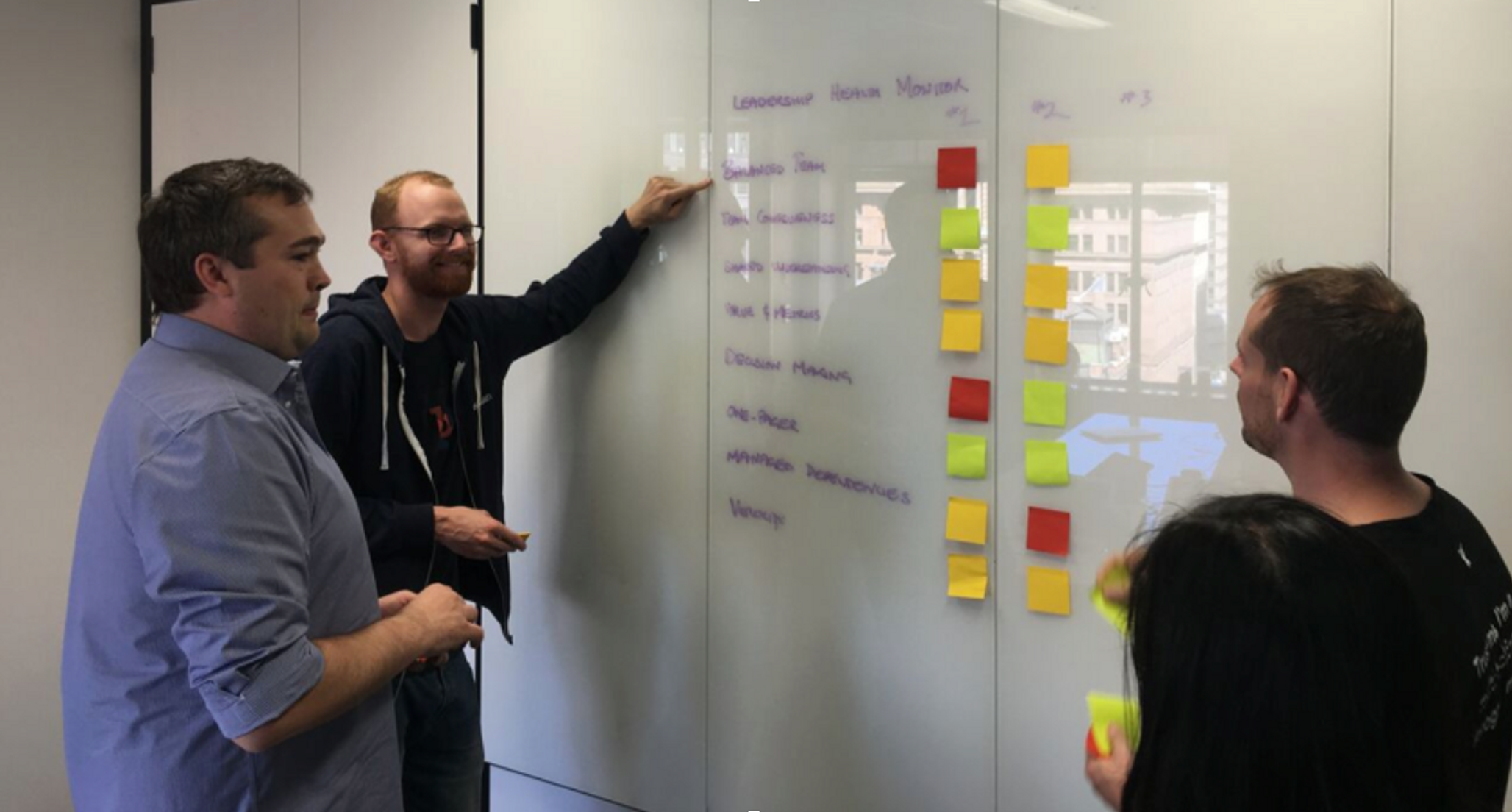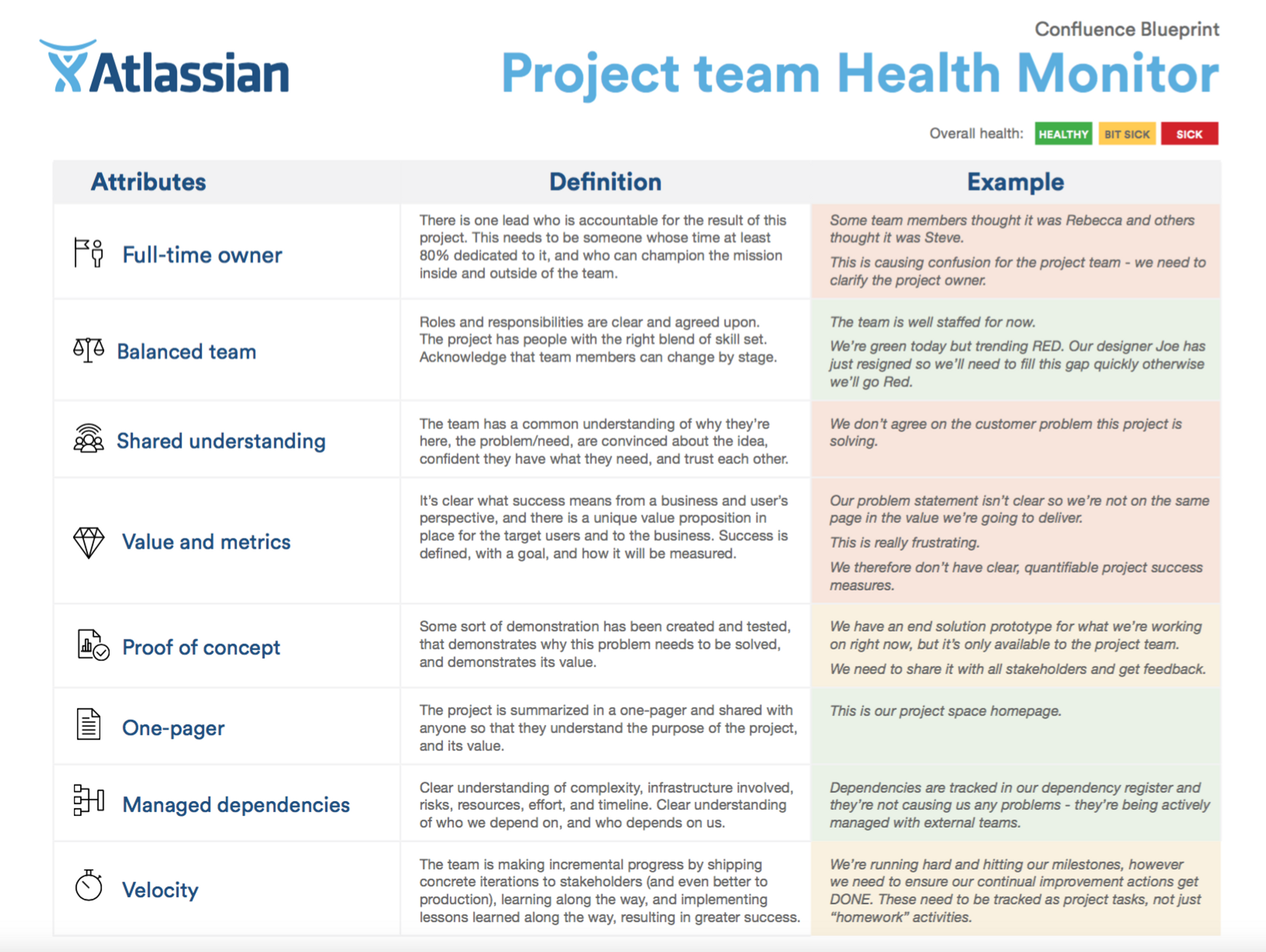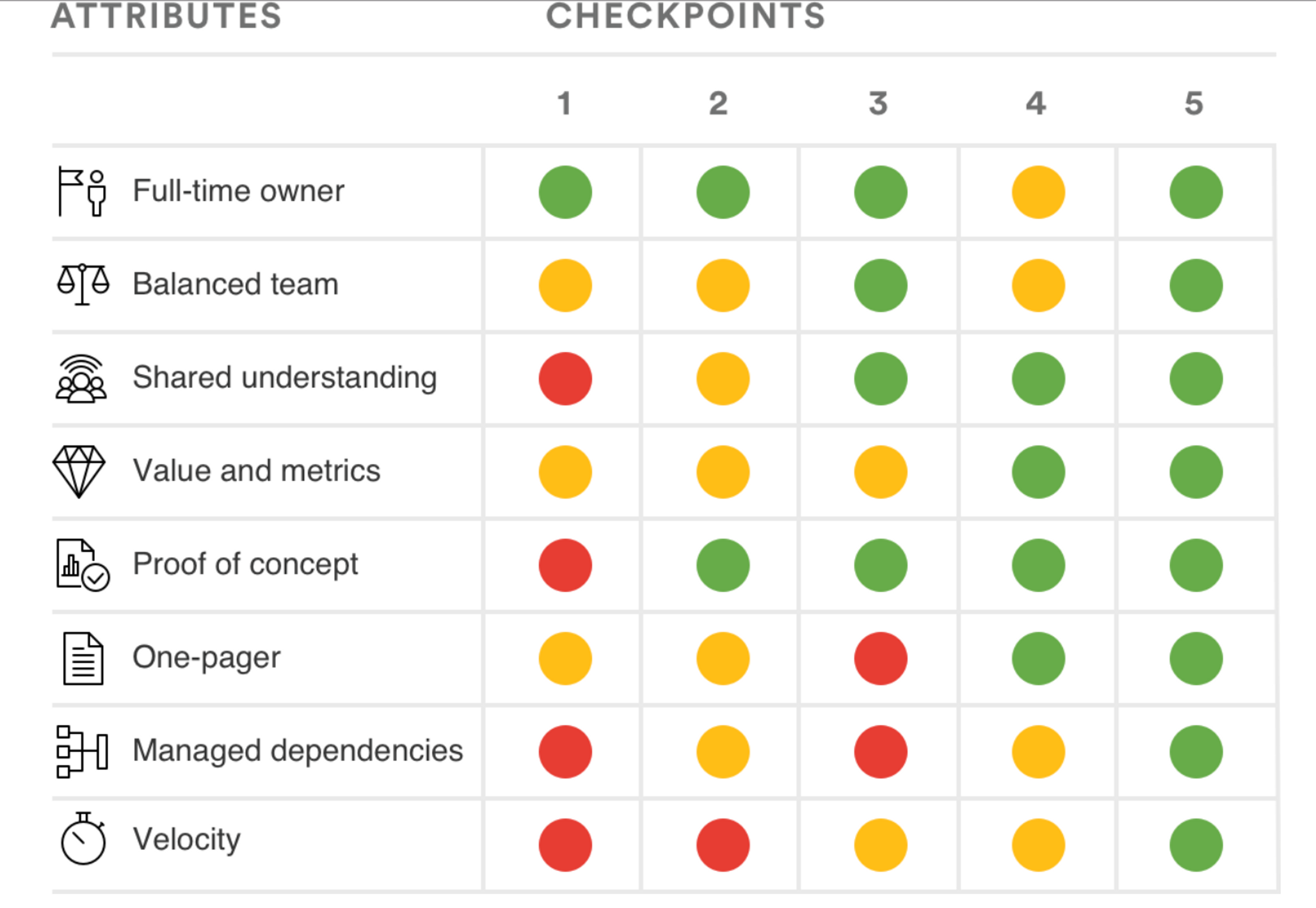In sports, the name on the back of a jersey can garner more attention than the one on the front. It’s Lebron James, not the Cavaliers, or J.J. Watt, not the Texans. These stars are put on pedestals and heralded for their incredible skill and accomplishments. They share one important key to success though, argues Jay Simons, president of enterprise software company Atlassian: they belong to great teams. Simons believes that when it comes to both sports and business, it’s the power of the team that makes the difference. Teams are the real reason why organizations are successful — not just the superstar power of a few standout individuals.
Simons is not alone in this belief. Over 400 organizations including Nike and Virgin have invited Simons and his team to teach Atlassian’s method for assessing, monitoring and improving team health. Atlassian has open-sourced its team playbook, which includes team-specific health assessments as well as tactics for working through common pain points, like leadership deficits or conflicting priorities. Simons and his colleagues are so passionate about the topic that the company’s NASDAQ ticker symbol is TEAM. Prior to Atlassian, Simons was the VP of Marketing at software-maker BEA Systems, which was acquired by Oracle.
Drawing from his talk at First Round’s CEO Summit, Simons outlines the eight traits of successful teams, determined after an studying hundreds of Atlassian teams across departments. He lays out the six-step process that’ll help teams of any kind, at any size company understand where they might need improvement. Lastly, Simons shares examples of how Atlassian teams have made adjustments to their processes after assessing their performance with the help of a health monitor.
How You’re Measuring Performance Isn’t Enough
Early on at Atlassian, Simons and his colleagues regularly assessed individual performance, as most companies do. Those performance reviews would help identify the roughly 5% of the overall workforce that was underperforming. They studied this group and noticed that, in the vast majority of cases, they were comprised of formerly high-performing people who were delivering below-average results. That’s when they spotted an unfortunate trend: star individuals — those rated highly in consecutive performance reviews — who were moved to struggling teams then became underperformers themselves. Simons and other managers began to ask how they could determine what was missing and broken. That’s when they realized that team health is a crucial priority for any growing organization.
Atlassian began to hone in on the issue after a few painful incidents borne of bad teamwork at the company, which operates on five continents and employs over 1,600 people. Simons and his team looked at teams and projects that had been successful — ones that had become company lore, were mentioned with smiles, or spawned their own T-shirts — and contrasted them with bad projects — the ones that were mentioned in hushed tones or silence. Qualitative data gave Atlassian enough of a hypothesis to quickly pinpoint and test attributes, rather than get mired in a complex initial methodology. Comparing and contrasting sentiment on successful and unsuccessful teams helped propel the process out of the gate.
The ultimate goal of examining these two categories of teams was to hone in what made the successful teams great and identify the deficiencies of the underperforming teams, particularly those where their rockstars’ performance was faltering. Over the course of their work, Simons and his colleagues identified eight elements of successful teams — that is, the key attributes and tools characteristic of teams that consistently outperformed others — and tested it with 40 teams. This criteria was developed for functional teams such as engineering and marketing; the company has also created Health Monitors for leadership teams and service teams.
The Eight Elements of Healthy Teams
Proof of concept. In fact, it’s not just a proof of concept, but a reason for — and clear path toward — continued effort. It’s vital that people understand not only why a project exists, but also why they must work on it in a particular way. “We found successful product teams had some kind of end-to-end walk-through that proves why the problem needed to be solved, the best path forward and why it would work,” Simons says. “Teams often agree on the end goal of the project, but each individual can have a different way of getting there. We had one engineering team that created a document showing three ways of solving a problem, and demonstrating why one way made the most sense.”
One-pager. Successful teams all had a readme that explained what they were trying to do and how they measured success. It was designed and summarized so that any colleague — on or off the project — could quickly get up to speed. “It described the elements and parameters of the project simply, in a way team members could digest, and it could be used to onboard others,” Simons says. “For example, a helpful one-pager had at least the following: a charter, which spelled out the team’s mission, and a bulleted list of the goals the team is delivering, so that others could quickly understand the steps to success.”
Velocity. Velocity is defined as forward momentum. In the context of startups, that’s the push to always be shipping. “Successful teams had two key components of velocity: a method for tracking and sharing progress with the company, and a schedule for delivering concrete pieces of work to stakeholders in an incremental way,” Simons says. “Successful teams broke down their work into manageable chunks of two-week sprints, after which they shipped their work, reflected on their performance and shared results with the organization.”
Full-time owner. Successful teams could identify a single individual or lead that was accountable for each component of a project. “How often have you been part of a team where it feels like everybody needs to get in the room to make a decision? That's a failure in having a full-time owner of an aspect of a project,” Simons says. “This trait tends to be a linchpin and is related to the health of the other seven attributes. The more individual accountability we found in a team, the better the team tended to do on the other success traits.”
Ask teams who’s accountable for various parts of a project. Unsuccessful teams have to talk about it. Successful teams can point to the owner.
Value and metrics. Team members need to understand and agree on success metrics. “Successful teams know the value they’re trying to deliver; metrics are how they know they’re being successful. Ever come out of a meeting where everyone agreed, but then pursued slightly different directions after they convened?” Simons asks. “In one case, we had a team that was ready to kill a certain feature, but they were stuck. We found the PM and engineering leader disagreed on the value and metrics for that project. The eng leader wanted to save time for one type of customer while the PM wanted to increase usage across many types of users. Once we acknowledged and addressed that misalignment, the team was able to ship.”
Shared understanding. Simons found that top teams trusted each other and were fully on board with their collective goal. “Successful teams had a shared belief in the why of what they were doing. It wasn't enough to understand what or how. They needed a conviction around why their project mattered,” Simons says. “We had one team whose leader was pushing fast decisions without explaining his reasoning. People were unclear on their responsibilities and instead were just running around putting out fires that had been started by him. The team made a push to get on the same page, implementing a one-pager and end-to-end proof of concept document. Impressed, the leader pledged to a new rule that every decision he’d make would come with a short, three-line explanation. Within weeks, their teamwork improved dramatically.”
Balanced team. Successful teams also had a varied set of skills, talents, work experiences and problem-solving styles that made sense for the project that they were working on. “A mix of all these attributes doesn’t guarantee success, just as a homogenous group won’t. The former, if done haphazardly, can feel like a tax, while the latter leads to groupthink,” says Simons. “The key is a team with a shared understanding and full-time owners that also features people from varied professional and personal backgrounds. Operating under the same rules, their differences lead to divergent and more creative thought. That’s when great things happen.”
Managed dependencies. Star teams also managed their reliance on other individuals, teams and projects. “Sometimes a holdup on a project is due to a circumstance that’s out of your hands. Successful teams documented those dependencies and understood the associated risks. They built clear plans and check-ins for working through them,” Simons says. “We observe that the best teams have a plan for managing their top two to three dependencies. They check-in with each other on them — and not just when something’s about to hit the fan. Low-performing teams know they’re in a complex environment but grind away and hope for the best. Teams must accept that externalities will impact their work and plan to mitigate them.”

The Six Steps to Evaluating Team Health
After their research, Simons and his team had narrowed down the successful traits for teams. They were determined to put them to work. “At the start of a project or a formation of a new team, we wanted to be able to use this framework to help propel a group in the right direction. We created a team health monitor as a way to help them better understand some of the things that make successful teams tick. It’s also a tool to diagnose weak spots,” Simons says. “This isn’t a performance review, which largely reflects what you did in the past and forces people to put their guard up. We want shields to be down and teams to park defensiveness at the door — both of which tend to be active in a critical review.”
At Atlassian, team health monitor sessions led to an improvement in team morale: people reported being happier and more productive. Teams became far more likely to hit their goals. Perhaps the most convincing endorsement of the health monitors was their usage went up — they weren’t requirements for teams, but they were using them of their own accord.
Set the Stage
Here’s how a team health monitor works, including what and who you need. Let’s start with ground rules:
- Initiate a health monitor at will. Any teammate can trigger a team health monitor.
- Create “two-pizza teams.” As coined by Jeff Bezos, these are groups of 6-10, essentially the size of team that can be fed by two pizzas.
- Do health monitors regularly. This varies, but the key is to develop a cadence. At Atlassian, one team ran a five-minute review every morning, while more stable teams did them every two to four weeks. “Don’t run it so often you get frustrated because you can’t take action on the findings, but no so infrequently that you find things you could have avoided,” Simons says.
Each health monitor takes one hour. Here’s how the meeting breaks down:
- 20 minutes for setup and ground rules
- 20 minutes for talking through the assessment
- 20 minutes for reflecting the results and agreeing on remedie
Each health monitor requires the following tools and participants:
- Post-it notes (red, yellow and green)
- Whiteboard
- A grid listing the eight tools and traits of star teams
- 6-10 participants
- A team facilitator, who leads the session.

The facilitator is key function for any health monitor. At Atlassian, Dominic Price, the company’s head of R&D, was their chief facilitator. “When we promoted the notion of the team health check really early on, we dressed Dom in a doctor's suit and put little funny flyers everywhere just to get people curious about what it was, and to just to make it lighthearted and interesting,” Simons says. “Dom sets the tone for the session: We're not trying to identify individuals or challenges with individuals. It's meant to be this constructive, open dialogue just about how things are working. There's no judgment here. It's mostly around just trying to have teams look in the mirror and figure out where they are, where they stand.”
The facilitator sets the tone for the session and gives basic rules of engagement:
- There are no right or wrong answers.
- Everyone's opinion is equal.
- Listen. Listen hard.
- Don’t settle, or say things are OK just to move on.
- It’s not about the leader or an individual, instead it’s a constructive and open dialogue about better collaboration.
- Don’t dive into problem-solving until the end.
Assess the Vital Signs
Once you’ve set up the room and laid down the ground rules, split the team of 6-10 people into groups of two or three. “The reason we break up the original group into smaller teams is to balance a diversity of viewpoints in an environment where each one can voiced. Then the groups reconvene to try to reach agreement around where things stand,” Simons says.
These small groups should decide how well the team rates on each of the eight attributes of successful teams by placing a red, yellow or green post-it note by each trait. Red stands for bad, yellow stands for so-so and green stands for good. With each rating, groups write one — and only one — bullet point or observation that led them to pick that color. Resist the temptation to solve problems at this stage — instead, just focus on observations for now and getting raw ratings as small teams on the board.
“It could be like saying there are holdups due to another team with which you share a managed dependency, or it could be that you feel your team is terrible at aligned values because everyone seems to always value different things — perhaps one group of people values speed, and the other group values quality. This naturally creates friction,” Simons says. “But the point is to boil down every rating to one key takeaway, so that you can pinpoint exactly why you feel the way you do in one sentence. Explain that everyone’s view is acceptable, and have people give their ratings before they speak. It gives everyone equal footing and gets the introverts involved, and increases the chances of candid conversation.”

Discuss the Ratings
Your facilitator — Dom, in Atlassian’s case — then helps the whole group find consensus around their ratings. The smaller teams come back together to talk as a whole. Each group talks through why they rated an attribute the color they did. Dom asks questions to find commonality. His goal as a facilitator is to arrive at a single rating for each attribute across the entire team of 6-10 people. “The rule here is where there's discrepancies or differences of opinion, we always downgrade. We try to look for consensus or unanimous voice versus just one strong voice. Where there’s dissension, we always downgrade to yellow or red and say that there's some things that we can work on to get everybody on the same page."
At this point, you might have a lot of red and yellow post-its on the board. Don’t panic. “Remember, there’s no judgment here. This is the first of what will be a regular set of checkpoints our team will do together. You may do them quarterly or every other month or even monthly. It’s simply a yardstick you can use to improve,” Simons says. “The key in this part of the process is to keep asking ‘why’ and ‘how’ questions — why does this team feel the way it does? How did things get this way? Keep diving deeper and more specific. Eventually you’ll find the root of the issue, and be able to strip it down to a clear problem.”
Agree on Focus Areas
Now it’s time to spend around 20 minutes picking two or three things marked red or yellow to work on. Your facilitator should suggest different ways the team can move the ratings in a positive direction. Guide the conversation towards items that are actionable, specific and measurable, and create clear due dates and assignments for those items.
“Now we have a base line. We've picked two things that we're going to work on over a period of time. That's actually good enough. We can move forward from there,” Simons says. “Once you’ve agreed on those focus areas, you can move to the next step: finding remedies.”
Find Remedies
The health check serves to highlight areas that teams can work on and how they should plan to approach it. Now it’s time to drill down and get more specific about the remedies for tackling these issues. “In many cases, we had frameworks already in place to help teams go green: a framework for decision-making, a template for a one-page readme or project guides and checklists for a proof of concept or metrics,” Simons says. “They weren’t being used because people didn’t identify the need. That’s what the health check did — it highlighted a deficiency or pain point and pointed groups toward solutions that often were already in place to help. It was incredibly powerful.”
In one scenario, a team was unhappy with their velocity. They didn’t have a clearly defined mission and weren’t delivering on their deadlines. “Their remedy, which is really common in these situations, is to complain about resourcing or about the number of people on the team. They said they needed more help. They could improve velocity if they added more people to the team. When we ran our health monitor, it demonstrated a lack of passion amongst the team. Adding more people into that environment actually compounded the problem,” Simons says. “The more people the team added, the slower they seemed to become. After this realization, they stopped just adding people to the team and instead focused on improving the fundamentals of how the existing group of people would operate together.”
In another case, Simons oversaw a marketing team that executed the health monitor. It soon became clear that there was a complete lack of shared understanding. “A go-through-the-motions offsite turned into a very real, productive, and specific discussion around trust between team members. They carved out time for individuals to have one-on-ones with each other, like biweekly coffees, to build more trust and understanding,” Simons says. “Now the health monitor is a recurring part of this team’s weekly meeting, something they make room for and consistently reinforce. And it all started with that red post-it.”
Schedule a Check-Up
Once you’ve reached a consensus on the problem areas and what needs to be, return to the health monitor after a month or a quarter. “You need to be able to track the progress that you’re making on turning those reds and yellows into greens. If you’re not moving the needle on the two focus areas you picked out, it’s time to sit down again and talk about what’s going wrong. You might even engage the facilitator again for another session with the same set of ground rules to encourage openness and problem-solving,” Simons says. “The whole point of a team health monitor is to create improvement. The only way to know if you’re doing that is to check in regularly on how things are going.”

“I’ll share a success story: We had a smart but relatively inexperienced interim engineering leader who saw a lack of urgency on his team. No one stepped up to make a call, so people revisited decisions over and over again without any forward movement. He ran a team health monitor, which showed they were red on shared understanding. He immediately instituted an Atlassian exercise that forces team members to delegate who’s accountable for certain decisions,” Simons says. “Almost immediately, the team finally understood who played what role, who was making the decisions and at what time. Uncertainty decreased and trust increased. We saw him start to go from being an inexperienced leader to a critical agent in his team’s transformation. He was promoted faster than average and, more importantly, his team’s momentum increased noticeably.”
Like a physical, team health monitors are meant to be preventative. We’re issuing vitamins here, not painkillers.
Putting Health Monitors In Action
When it comes to monitoring the health of your organization, teams should take priority, not individual performance reviews, which can be overemphasized and over-leveraged. Keep in mind the eight traits of successful teams: individual accountability, diversity, shared beliefs, aligned values and metrics, proof of concept, a readme document, managed dependencies and velocity. Create a team health monitor session and have groups rate their team on each trait. From there, choose up to three issues to work on. Address problems that come up by looking to existing frameworks or using data to understand why previous approaches have failed.
“Superstars win games, but teams win championships. This is also true in business. A lot of times we chalk failures up to bad management or bad luck when really the real issue is bad teamwork. Teamwork is really, really hard. It’s messy. It’s important not to blame any one individual for those failures. Instead, dig into the meat of the problem by regularly incorporating these team physicals and associated check-ins,” Simons says. “We’ve found that by doing this, you wind up saving a lot of time and headaches in the long run. Right now, a lot of managerial focus is on the individual and individual performance. By shifting that energy to improving and strengthening teams, you’ll see an exponential improvement.”
